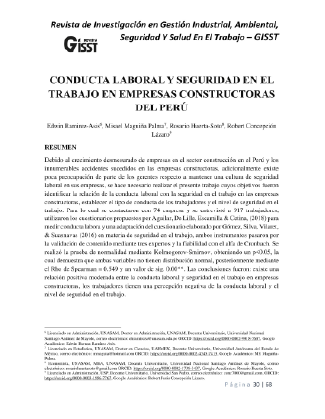I. LABOR BEHAVIOR AND SAFETY AT WORK IN CONSTRUCTION COMPANIES IN PERU
##plugins.themes.bootstrap3.article.main##
Abstract
Due to the disproportionate growth of companies in the construction sector in Peru and the countless accidents that have occurred in construction companies, additionally there is little concern on the part of managers regarding maintaining a culture of occupational safety in their companies, it is necessary to carry out the present work whose objectives were to identify the relationship of work behavior with occupational safety in construction companies, establish the type of behavior of workers and the level of safety at work. For which 74 companies were contacted and 917 workers were interviewed, they used the questionnaires proposed by Aguilar, De Lille, Escamilla & Cetina, (2018) to measure work behavior and an adaptation of the questionnaire developed by Gómez, Silva, Vilaret, & Suasnavas (2016) on safety at work, both instruments went through content validation by three experts and reliability with Cronbach's alpha. The normality test was performed using Kolmogorov-Smirnov, obtaining a p<0.05, which shows that both variables do not have normal distribution, subsequently using Spearman's Rho = 0.549 and a value of sig. 0.00**. The conclusions were: there is a moderate positive relationship between work behavior and safety at work in construction companies; workers have a negative perception of work behavior and the level of safety at work.
Download Statistics
##plugins.themes.bootstrap3.article.details##
occupational behavior, occupational safety, Psychosocial factors, Accident prevention, Occupational Safety, Construction sector
Argüello-López, G., Uribe-Bermúdez, J., & Valdivieso-Guerrero, M. (2017). Relación entre capacitación y actitud hacia los riesgos laborales en el sector construcción del área metropolitana de Bucaramanga. I+ D Revista De Investigaciones, 9(1), 14-26.
Briceño, L. (2003). Prevención de riesgos ocupacionales en empresas colombianas. Revista ciencias de la salud, 1(1), 31-44.
Corrales, C., Sánchez, C. & Toledo, G. (2014). Estudio de la Siniestralidad en Seguridad en Empresas del Sector Construcción a partir de la Nueva Legislación Peruana. In 12th Latin American and Caribbean Conference for Engineering and Technology 1–11. Guayaquil. https://bit.ly/33yNiyG
Hernández-Sampieri, R. & Mendoza, C. (2018). Metodología de la investigación. Las rutas cuantitativa, cualitativa y mixta, México: Editorial Mc Graw Hill Education, ISBN: 978-1-4562-6096-5, 714p.
Kouabenan, R., Ngueutsa, R. & Mbaye, S. (2015). Safety climate, perceived risk, and involvement in safety management. Safety Science, 77, 72–79. https://doi.org/10.1016/j.ssci.2015.03.009
Gómez, A., Silva, M., Vilaret, A., & Suasnavas, P. (2016). Diseño metodológico de la encuesta sobre condiciones de seguridad y salud en el trabajo en Ecuador. INNOVA Research Journal, 1(8), 1-14. https://doi.org/10.33890/innova.v1.n8.2016.41
Ley N° 29783, (2011). Ley de Seguridad y salud en el Trabajo. Diario oficial el peruano. 20 de agosto del 2011.
Mendoza, L. (2019). Gestión de la seguridad basada en comportamientos. Revista San Gregorio, n.31, 138-149. https://doi.org/10.36097/rsan.v0i31.964
Meliá, J. (2007). Seguridad basada en el comportamiento. En Nogareda, C., Gracia, D, Martínez-Losa, J, Peiró, J, Duro, A., Salanova, M., Martínez, I, Merino, J., Lahera, M., y Meliá. J: Perspectivas de Intervención en Riesgos Psicosociales: Medidas Preventivas. Barcelona: Foment del Treball Nacional y Fundación Nacional para la Prevención de Riesgos Laborales, 157-180.
Nunu, W. N., Kativhu, T., & Moyo, P. (2018). An evaluation of the effectiveness of the Behaviour Based Safety Initiative card system at a cement manufacturing company in Zimbabwe. Safety and health at work, 9(3), 308-313.
Organización Internacional de Trabajo. (22 de 01 de 2019). Organización Internacional de Trabajo. https://bit.ly/39bpB0J
Organización Mundial de la Salud, OMS (30 de 11 de 2017). Protección de la salud de los trabajadores. https://bit.ly/39dVKV8
Ortiz, D. (2018). Directrices para la gestión de la seguridad y salud laboral de empresas constructoras de ecuador. (Tesis de maestría). Universidad Politécnica de Madrid, España.
Pérez, U. (2013). Seguridad e higiene laboral aplicada a las empresas constructoras de la Cabecera Departamental de Quetzaltenango. (Tesis de pregrado). Universidad Rafael Landívar, Guatemala.
Salvador M, J. E. (2018). Riesgos psicosociales del aeropuerto de Manta. Revista San Gregorio, 22, 30-39.
Taufek, B., Zulkifle, B. & Kadir, B. (2016). Safety and Health Practices and Injury Management in Manufacturing Industry. Procedia Economics and Finance, 35, 705–712. https://doi.org/10.1016/s2212-5671(16)00088-5
Yoon, S. J., Lin, H. K., Chen, G., Yi, S., Choi, J., & Rui, Z. (2013). Effect of Occupational Health and Safety Management System on Work-Related Accident Rate and Differences of Occupational Health and Safety Management System Awareness between Managers in South Korea’s Construction Industry. Safety and Health at Work, 4(4), 201–209. https://doi.org/10.1016/j.shaw.2013.10.002

